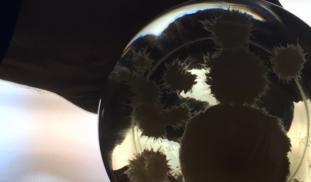Flame Retardants in Sewage Sludge? Of Course!
Why do we do what we do, she asked? Why would anyone study the production, processing, chemistry, microbiology, toxicity, disposal and fate of toxic sewage sludge? Why would anyone care?
We do what we do because we are inspired to prevent chronic diseases, the greatest cause of suffering and death of humans, much of which is a consequence of long-term exposure to environmental contaminants and pollutants. Any questions?
We suffer inspiration. We are inspired to find the causes of chronic disease, i.e., the toxins (biological) and the toxicants (chemical) that impact our very core biology, and then eliminate them from our living environment. But lo and behold, someone out there values commerce, the tax base and profit over public health and safety, much less human and environmental health.
Inspiration guides us, too, to find new cures, and well as to understand prevention, the ultimate cure.
No one knows what's in the toxic sewage sludge that is disposed in our living environment, as discarded in our forests or on our rangelands or farms. The ever-mutable chemistries and microbiology of sewage sludge remain unknowable, and no agency or facilitator of such insensitive practice ever wants to know - for, what would they do with it if they could no longer dispose of it in our soils and waters, and therefore in our foods and into our very sustenance?
We take an oath to remain inspired!
So many people are working the challenge of identifying the toxic chemicals and infectious agents to which we are exposed everyday by the lazy and lucrative practice of land-disposed sewage sludge. We are inspired simply to protect ourselves, if for no other reason.
Leading activists and scientists are inspired to investigate the issue, for example:
- March 05, 2015. Bipartisan Bill Banning Toxic Flame Retardants Overwhelmingly Passes House. Olympia, WA. The Washington State House of Representatives passed a ban on toxic flame retardants in home furniture and children's products tonight …. The Toxic-Free Kids and Families Act, would reduce children's and firefighters' exposure to harmful flame retardants by prohibiting their use in children's products and furniture. The bill would also provide the Department of Ecology with the ability to ban additional cancer-causing and other harmful chemicals from being used as flame retardants, provided safer alternatives are available (Where'd that come from?).
- March 31, 2015. Environmental Health News. A group of firefighters, scientists, and health and consumer advocates are petitioning federal authorities to ban children's products, furniture, mattresses and electronic casings if they contain a class of flame-retardants. The petition, announced today and put together by the Green Science Policy Institute and Earthjustice, calls on the Consumer Product Safety Commission to ban these products if they contain organohalogens flame-retardants, a class of chemicals that have been linked to cancer, hormone disruption, and reproductive, developmental and immune system problems. Organohalogen and organophosphorous flame retardants are considered as being Persistent Organic Pollutants (POPs), such as the polybrominated diphenyl ethers or PBDEs, and are organobromine compounds that are used as flame retardants. Like other brominated flame retardants, PBDEs have been used in a wide array of products, including building materials, electronics, furnishings, motor vehicles, airplanes, plastics, polyurethane foams, and textiles, and present significant risks to human health and environment. PBDEs, used primarily as flame retardants in furniture, are structurally similar to the known human toxicants PBBs, PCBs, dioxins, and furans. In addition to having similar mechanisms of toxicity in animal studies, they also bio-accumulate in both humans and animals and persist in the environment.
- September 17, 2014. Seattle. Washington Toxics Coalition. Scientists have been puzzling over why toxic flame retardant chemicals used in products in our homes, like couches and TVs, are showing up in Puget Sound, rivers and other waters across the state. Now they have an answer thanks to a new peer-reviewed study published in the journal Environmental Science & Technology. The first-of-its kind study uncovers how flame retardants used in products in homes accumulate on clothing, contaminate laundry wastewater and pass through wastewater treatment plants to pollute rivers and other waters.
Many brominated chemicals are under increasing criticism because of their use in household furnishings and where children may come into contact. PBDEs are found in people all over the world. Some brominated flame retardants are identified as persistent, bioaccumulative and toxic to both humans and animals, and are associated with neurobehavioral effects and endocrine disruption.
While we may be inspired to find the causes of chronic disease, no agency or no regulatory authority mandates or conducts any analysis of any flame retardants in any sewage sludge that is land-disposed in our forests or on our rangelands or farms. What's for dinner?

Recognized to be True.

Revealed; not Concealed.

Our Duty.







0 comments